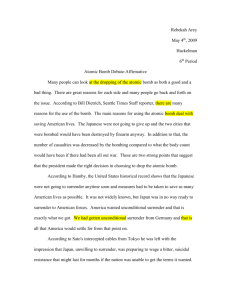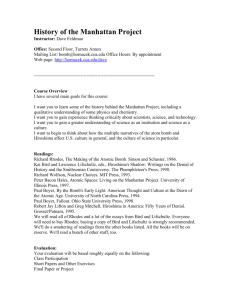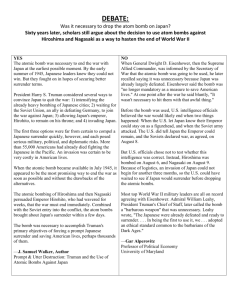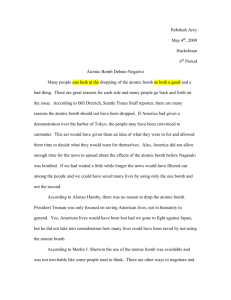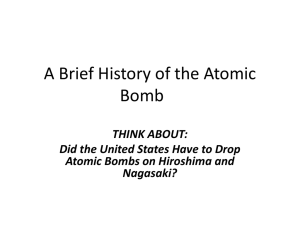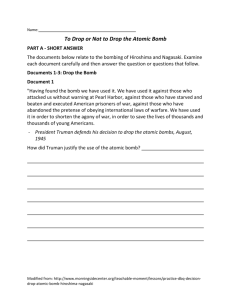Atomic Bomb - George Washington High School
advertisement
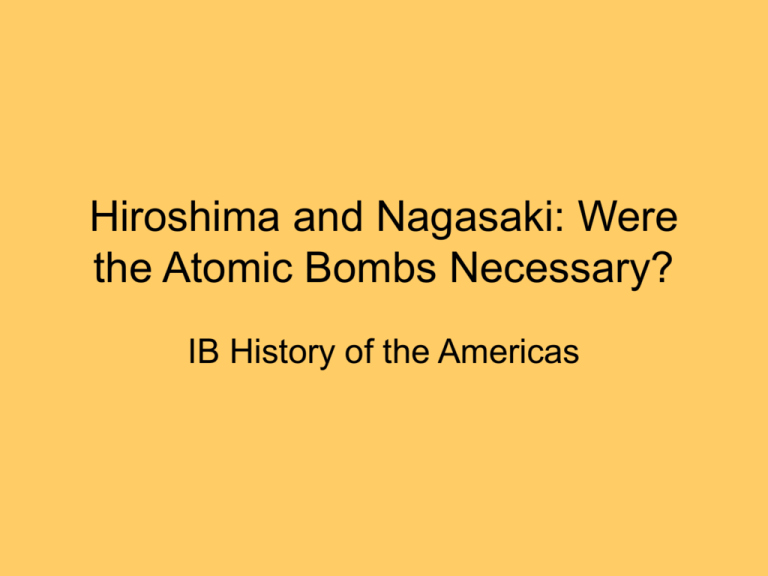
Hiroshima and Nagasaki: Were the Atomic Bombs Necessary? IB History of the Americas “My God, What Have We Done?” John Lewis, Co-Pilot of the Enola Gay Hiroshima and Nagasaki Japan • The atomic bomb named "Little Boy" was dropped on Hiroshima by the Enola Gay, a Boeing B-29 bomber, at 8:15 in the morning of August 6, 1945. “Fat Man” was dropped on Nagasaki 3 days later on August, 9, 1945. • 140,000 Killed in Hiroshima (mostly civilians) • 74,000 Killed in Nagasaki (mostly civilians) What Is the Atomic Bomb? • The atomic bomb is a nuclear weapon that derives its destructive force from the nuclear reaction of fission • So powerful- a single weapon is capable of destroying an entire city. Post WWII model of the “Little Boy” atomic bomb dropped on Hiroshima. www.atomicarchive.com Hiroshima Blast Bomb had a height of 580 meters and then erupted into an enormous fireball like the sun. More than a million degrees Celsius at its center, the fireball reached a maximum diameter of 280 meters in one second. Surface temperatures near the hypocenter rose to 3,000-4,000℃. Damage to Buildings 90 percent of all buildings burned or destroyed beyond repair. Effects • Detonation of atomic weapons have many effects, both short and long term, including thermal effects, blast effects, and radiation. www.atomicarchive.com Radiation . Those exposed within about 1000 meters of the hypocenter received life-threatening doses, and most died within a few days. Leukemia and other cancers appeared over the course of 2 to 20 years, and radiation effects still threaten the health of the survivors. Birth Defects Radiation harmed fetuses in various ways. Some were stillborn. Some children were born without obvious problems but had higher mortality rates Development tended to be slower than that of other children. Microcephaly Those who were exposed close to the hypocenter in early pregnancy were likely to display microcephaly (abnormally small heads) accompanied by severe mental retardation that renders them unable to manage everyday life without assistance. The Blast Pressure The wind velocity on the ground beneath the explosion center was 980 miles/hr, which is five times stronger than the wind generated by strong hurricanes Blast Effects The effects of the blast wave on a typical wood framed house. http://www.atomicarchive.com/Effects/effects3.shtml www.atomicarchive.com • This heat cause a high-pressure wave to develop and expand outwards, creating the blast effect. The front of the blast wave, known as the shock front, is a wall of highly compressed air. Relief The atomic bomb instantaneously destroyed the government offices, City Hall, the police stations, and all government buildings. The next day, the Japanese Army Marine Headquarters which sustained only slight damage, took the lead in establishing the Hiroshima Security Regiment Headquarters. The military, the government, and the people united to carry out relief activities, often with little understanding of the effects of radiation. Manhattan Project The Manhattan Project was created in order to establish the first nuclear bomb that would help to end World War II in the Pacific. Top scientists from around the world such as J. Robert Oppenheimer, Enrico Fermi, and Albert Einstein, along with many of the Army Corps of Engineers’ finest were recruited to work on the project. Although called the Manhattan Project it was no where near the location of Manhattan. Rather, it was about 2500 miles away in Los Alamos, New Mexico. http://en.wikipedia.org/wiki/Manhattan_Project J. Robert Oppenheimer, Director of the Manhattan Project “We knew the world would not be the same. A few people laughed, a few people cried, most people were silent. I remembered the line from the Hindu scripture, the BhagavadGita. Vishnu is trying to persuade the Prince that he should do his duty and to impress him takes on his multiarmed form and says, ‘Now, I become Death, the destroyer of worlds.’ I suppose we all felt that one way or another.” Effects • Social: By the end of the conflict with Japan the world began to realize the power that one country can have. Seeing this we learn later that it only takes one strategically positioned nuclear warhead to cause the world to end. People were effected by this psychologically in that they created bomb shelters and survival plans. • Political: Once the war ended politics became a totally different ballpark. The United States entered the Cold War against the USSR and was pushed into an arms race led by the political engines of both nations. • Economic: During WWII, the manufacture and distribution of nuclear arms was not much of a threat due to the fact that only the US had them in its arsenal. Arguments for Dropping the Atomic Bomb 1. Save (1,000,000?) American and Japanese lives. Japanese resisted US forces by use of Kamikaze pilots in Okinawa and fighting without surrender at Iwo Jima and other battles. They didn’t surrender after the fire bombing of major cities, nor after Hiroshima. 2. End the war quickly. The US was tired after 4 years of war. Germany had already surrendered in May, 1945. Japan resisted an unconditional surrender. 3. Demonstrate US power to the world. 4. Racism. US policy makers expressed racist attitudes toward Japanese 5. Revenge. Truman suggested after the war that he wanted to exact revenge for Pearl Harbor. 6. Large resources went into the development of the atomic bomb, and there was a desire to use it and test it. 7. As an unelected President, Truman was controlled by his close advisors who favored using the bomb. Kept in the Dark as VP under FDR. Arguments Against Dropping the Bomb 1. Moral failure for being the only country to use an atomic bomb in war. The attack struck mainly civilians who outnumbered military personnel 6:1. 2. Japan may have been ready to surrender. It was blockaded. Its navy and air force was destroyed. It’s overseas possessions were confiscated. 3. The US needlessly insisted upon an unconditional surrender, since Japan was willing to surrender if it could retain the Emperor. 4. US moral authority, nationally and internationally, was weakened. 5. Contributed to mistrust held by the USSR and prompted a dangerous arms race. 6. Some argue there was no need for the second bomb on Nagasaki. 7. There were many prominent military personnel against dropping the bomb, like Eisenhower, under-Secretary of the Navy, Ralph Bard, Army Chief of Staff General George C. Marshall, and Admiral Chester W. Nimitz, Commander in Chief of the Pacific Fleet. 8. Couldn’t they have dropped the bomb in the water as a threat to force the surrender?
